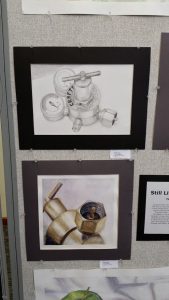Dustin Edwards argues that remixes should be “distinctive in purpose, delivery, design and style” (42). I noticed that the posts published so far on this topic are mostly about the remixing of stories, videos, and songs. The first time I considered copyright beyond written text, it was in an art classroom. At the start of my high school career, I avoid originality like the plague and relied wholly on my technical skills to copy what I saw in front of me for all of my art projects. This of course, did not go unnoticed by my art teacher. Once we moved past still-life drawings and paintings, he encouraged me to

draw inspiration from art pieces I found on Pinterest without directly copying them. The only rule he gave me was that I could use other artists’ works as reference images only if I altered them enough so that they were no longer recognizably as that artist’s. This encouraged me to use more creativity and explore new styles/techniques. Until reading these excerpts, I never considered my projects as remixes. Learning to remix art (even though I wasn’t aware of the term) made me feel like a “real” artist.
Lawrence Lessig’s chapter

introducing remix reminded me of my high school art teacher’s rule. The lawyers involved with the legal cases Lessig references would probably disagree with my teacher. Edwards, however, might accept my remixes as stylistically distinct. This shows how subjective remix truly is by nature. When I read Emily Dilworth’s post, I immediately heard my art teacher’s voice in my head and thought that the art she references was not distinct enough to pass as original. Replacing a line of text, to me, is not enough to claim a work as your own. I would be interested to hear other’s opinions on how much altering an image needs to be considered original, and what laws exist concerning copyright laws of physical art specifically.
Final word count: 337
Works Cited
Edwards, Dustin W. “Framing Remix Rhetorically: Toward A Typology of Transformative Work.” Computers and Composition, JAI, 24 Dec. 2015, www.sciencedirect.com/science/article/pii/S875546151500095X.
“Introduction.” Remix, by Lawrence Lessig, pp. 1–19.
